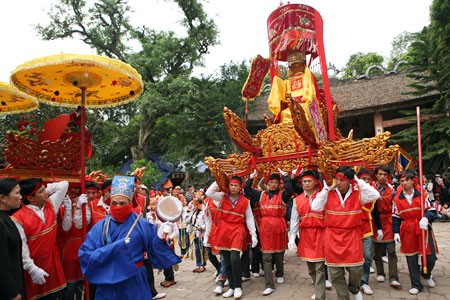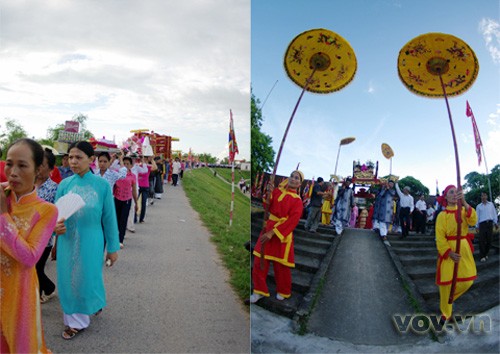(VOVworld) Spring is Vietnam’s main festival season, a time when people pray to their genies for protection. Saint Chu Dong Tu is one of the four immortal gods in the Vietnamese pantheon. Reporter To Tuan explains the romantic legend behind the Chu Dong Tu Festival in the northern province of Hung Yen.
 |
| A procession of God palanquin |
A long time ago in the kingdom of Van Lang, there lived a king named Hung Vuong the 18th. His daughter, Tien Dung, developed a love of nature and spent her days wandering around the many wondrous places of her father’s kingdom. One pleasant day, while Tien Dung, accompanied by her servants and guards, was searching for new places to explore, their journey led them to a village called Da Trach. She expressed a desire to bathe in the river. Granting her wish, the servants set up a tent on the shore. The princess entered and disrobed, and began pouring water on herself. As the water trickled to the ground, it began to wash away the sand with which a young man named Chu Dong Tu had covered himself, revealing the man’s completely naked body lying beneath her feet.
Startled by Chu Dong Tu’s appearance, Tien Dung quickly covered herself up while the terrified young man lay motionless on the ground, his head turned away begging her pardon. He explained to the princess that he had used his only garment to clothe his dead father and had to hide himself from people and fish in the dark. To conceal himself from the princess and her servants, he had hid under the sand just at the spot where Tien Dung had decided to bathe.
Realizing the young man had done nothing wrong, the princess could not be angry with Chu Dong Tu. Recognizing that fate had allowed their paths to cross, she ordered her officers and maids to clothe the young man and prepare for their wedding. Tien Dung settled with her husband in his small village and earned a living by trading. With Chu Dong Tu’s business experience and Tien Dung’s charm, their trade flourished and the village of Chu Xa soon became famous. Merchants of that kingdom and neighboring kingdoms came to do business with the young couple. Nguyen Hong Thuan of Da Trach Village recalls the story: “Princess Tien Dung taught the villagers wet rice cultivation and provided healthcare to many local people and even her father. The community built temples in 72 communes to worship the Princess. When the couple died, they left a stick and a conical hat, around which people built a temple and began to hold an annual ritual on the 10th day of the 2nd lunar month.”
 |
| Pilgrims with offerings on their heads flock to the temple |
For the celebration, pilgrims elaborate costumes come to the two temples in Da Trach and Da Hoa. After the opening ceremony, there is a procession to remind people of the legend, life and work of Saint Chu Dong Tu. Heading the procession are the two richly-decorated dragons controlled by dozens of young people moving to the rhythm of a drum. The procession includes musicians, a God palanquin and eight ornamental weapons. Participants sit in dozens of boats, row to the middle of the river and scoop water into pots for later offering at the temple. The festival includes various forms of entertainment such as wrestling, fighting with sticks, human chess, and traditional dances.
Unattached people visit the festival to find a wife or husband. Foreigners see the event as an Oriental Valentine’s Day. Ha Van, a student from Hanoi, said: “This is my 2nd time at the festival. I enjoy taking photographs and exploring the historical and cultural values of the event. It’s very pleasant.”
The dragon procession, martial arts competitions, lion dance, and folk songs combined to make this festival grand, colorful and wildly popular.
To Tuan